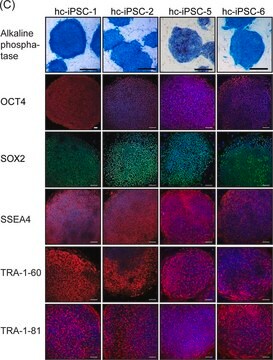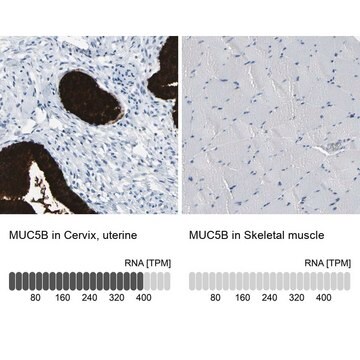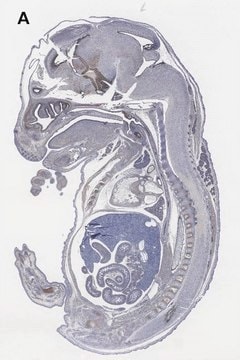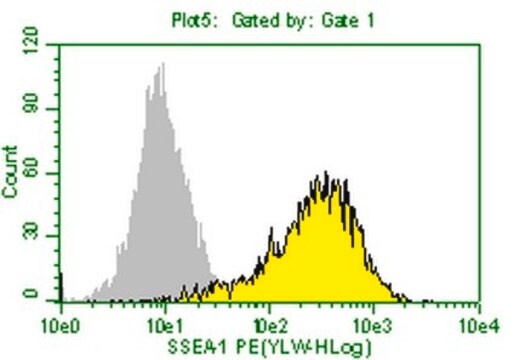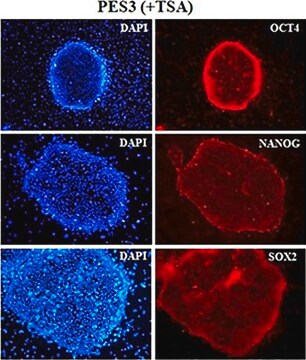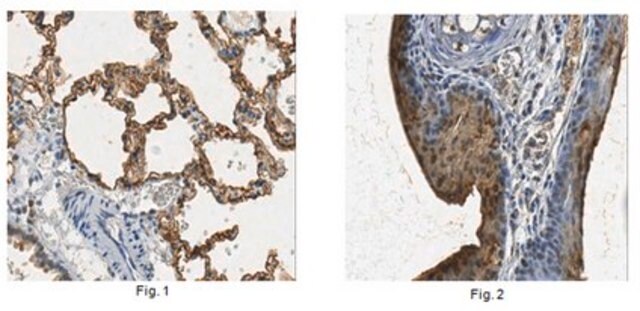おすすめの製品
由来生物
mouse
品質水準
結合体
PE
抗体製品の状態
purified antibody
抗体製品タイプ
primary antibodies
クローン
MC-813-70, monoclonal
化学種の反応性
human
メーカー/製品名
Milli-Mark®
テクニック
flow cytometry: suitable
immunocytochemistry: suitable
アイソタイプ
IgG3κ
輸送温度
wet ice
ターゲットの翻訳後修飾
unmodified
遺伝子情報
human ... FUT4(2526)
詳細
N-terminal GST-tagged, recombinant human MuRF1 full length, expressed in E.coli. Purified using glutathione sepharose.
The cell-surface markers used routinely to identify undifferentiated human embryonic stem cells (hESCs) were initially characterized as markers for mESCs, mouse embryonic carcinomas (ECs), or human EC cells. Stage-specific embryonic antigen-3 (SSEA-3) and SSEA-4 are widely used as cell-surface markers to define both human and mouse ESCs. SSEA-3 and SSEA-4 are expressed on undifferentiated hESCs but not on undifferentiated mESCs.
特異性
This antibody reacts with the stage-specific embryonic antigen-4 (SSEA-4) that is expressed upon the surface of human tetracarcinoma stem cells (EC), human embryonic germ cells (EG) and human embryonic stem cells (ES).
No immunoreactivity is evident with undifferentiated murine EC, ES and EG cells. Expression of SSEA-4 is down regulated following differentiation of human EC cells. In ctontrast, the differentiation of murine EC and ES cells may be accompanied by an increase in SSEA-4 expression.
No immunoreactivity is evident with undifferentiated murine EC, ES and EG cells. Expression of SSEA-4 is down regulated following differentiation of human EC cells. In ctontrast, the differentiation of murine EC and ES cells may be accompanied by an increase in SSEA-4 expression.
免疫原
Human embryonal carcinoma cell line 2102Ep.
アプリケーション
Research Category
幹細胞研究
幹細胞研究
Research Sub Category
多能性及び初期分化
多能性及び初期分化
Immunocytochemical staining of live H9 human ES cells incubated for 30 minutes at 37oC with 1:50 dilution of anti-SSEA-4, clone MC-813-70, PE conjugate (Cat. No. FCMAB116P) monoclonal antibody.
Pluripotent human ES cells exhibit strong immunoreactivity to this antibody.
Immunocytochemical staining of fixed H9 human ES cells incubated for 2 hours at 2-8oC with 1:50 dilution of anti-SSEA-4, clone MC-813-70, PE conjugated (Cat. No. FCMAB116P) monoclonal antibody.
Pluripotent human ES cells exhibit strong immunoreactivity to this antibody.
Pluripotent human ES cells exhibit strong immunoreactivity to this antibody.
Immunocytochemical staining of fixed H9 human ES cells incubated for 2 hours at 2-8oC with 1:50 dilution of anti-SSEA-4, clone MC-813-70, PE conjugated (Cat. No. FCMAB116P) monoclonal antibody.
Pluripotent human ES cells exhibit strong immunoreactivity to this antibody.
This Milli-Mark Anti-SSEA-4-PE Antibody, clone MC-813-70 is validated for use in FC, IC for the detection of SSEA-4.
物理的形状
Protein A purified
Purified mouse monoclonal IgG3 conjugated to PE fluorochrome in PBS with less than 0.09% sodium azide and 15 mg/mL BSA.
保管および安定性
Maintain refrigerated at 2-8oC protected from light in undiluted aliquots for up to 6 months from date of receipt.
アナリシスノート
Control
Pluripotent human embryonic stem (ES) cells
Pluripotent human embryonic stem (ES) cells
法的情報
MILLI-MARK is a registered trademark of Merck KGaA, Darmstadt, Germany
免責事項
Unless otherwise stated in our catalog or other company documentation accompanying the product(s), our products are intended for research use only and are not to be used for any other purpose, which includes but is not limited to, unauthorized commercial uses, in vitro diagnostic uses, ex vivo or in vivo therapeutic uses or any type of consumption or application to humans or animals.
適切な製品が見つかりませんか。
製品選択ツール.をお試しください
保管分類コード
10 - Combustible liquids
WGK
WGK 2
引火点(°F)
Not applicable
引火点(℃)
Not applicable
適用法令
試験研究用途を考慮した関連法令を主に挙げております。化学物質以外については、一部の情報のみ提供しています。 製品を安全かつ合法的に使用することは、使用者の義務です。最新情報により修正される場合があります。WEBの反映には時間を要することがあるため、適宜SDSをご参照ください。
Jan Code
FCMAB116P:
試験成績書(COA)
製品のロット番号・バッチ番号を入力して、試験成績書(COA) を検索できます。ロット番号・バッチ番号は、製品ラベルに「Lot」または「Batch」に続いて記載されています。
Vanessa Sauer et al.
Cell transplantation, 25(12), 2221-2243 (2016-08-12)
Although several types of somatic cells have been reprogrammed into induced pluripotent stem cells (iPSCs) and then differentiated to hepatocyte-like cells (iHeps), the method for generating such cells from renal tubular epithelial cells shed in human urine and transplanting them
ライフサイエンス、有機合成、材料科学、クロマトグラフィー、分析など、あらゆる分野の研究に経験のあるメンバーがおります。.
製品に関するお問い合わせはこちら(テクニカルサービス)